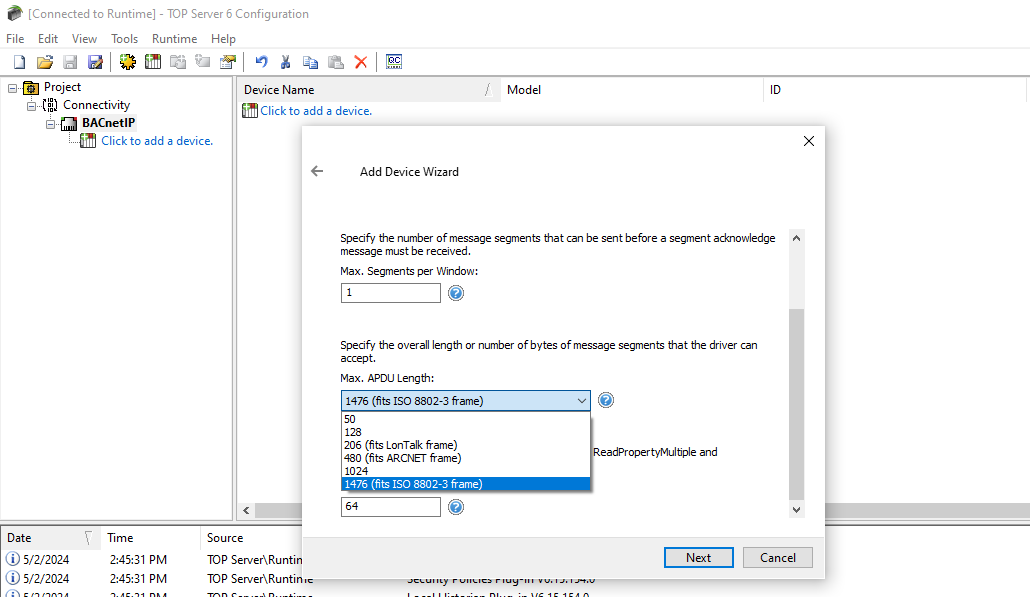The TOP Server® from Software Toolbox and KEPServerEX® from the Kepware division of PTC® are well known connectivity solutions for extracting industrial automation data from PLCs and other devices, and integrating that data with virtually any HMI, SCADA, MES, Historian, or database on the market. These products have a global installed base serving sophisticated users across every industry imaginable.
Software Toolbox Technical Blog
Configure TOP Server and KEPServerEX Remotely and Securely
5 min read
By Blake Giler on Sep 26, 2024 2:00:00 PM
Software Toolbox Helps You Fly Higher with Canary Historian
6 min read
By Connor Mason on Sep 19, 2024 2:00:00 PM
Welcome to the next installment of our Data Storage Deep Dive series! For years, Software Toolbox has been synonymous with terms like “device connectivity” and “data integration” thanks to our variety of connectivity solutions that help collect real-time data for all your industrial automation operations. Beyond just real-time data, our team recognizes the value of historical data within the industry, and we aim to help businesses make larger data backed decisions over time.
Data Storage Deep Dive: Your Intro to Unlocking Historical Data
8 min read
By Ryan Royse on Sep 12, 2024 2:00:00 PM
Welcome to the kickoff post of our Data Storage Deep Dive blog series! In this series, we will explore the crucial role of data storage solutions and Historians in industrial automation. Over the coming weeks, we’ll be looking into how solutions delivered by Software Toolbox can be utilized with Historians, helping you make the most of your industrial data.
Expanding your IoT Impact with the TOP Server MQTT Client Driver
6 min read
By John Gonzalez on Jun 20, 2024 2:00:00 PM
Welcome back to our Summer of IoT blog series! In this third installment, we continue our journey through the fascinating world of IoT, delving deeper into the transformative technologies Software Toolbox has to offer for shaping our connected future. Today, we will be highlighting the TOP Server MQTT Client driver and demonstrating how it can effortlessly integrate real-time data from MQTT brokers into your existing industrial automation systems, such as your HMI, SCADA, MES, or Historian.
IoT and You – Kicking off the Summer of IoT
8 min read
By Ryan Royse on Jun 6, 2024 2:00:00 PM
Welcome to the kickoff of Software Toolbox’s Summer of IoT blog series! Over the next few blog posts, we’ll discuss how our products can play a role in the exciting world of Internet of Things (IoT), but more importantly, how they can be used to further your success in Industry 4.0 and Digital Transformation initiatives. The IoT landscape has grown exponentially over the past decade, transforming industries by connecting devices, systems, and people in unprecedented ways. IoT is reshaping how we interact with technology. At Software Toolbox, we recognize the power of IoT and are committed to providing solutions that facilitate this technological revolution.
Video Tutorial: Data Collection from BACnet Controllers
2 min read
By Lauren Conrad on May 30, 2024 2:00:00 PM
Originally developed by the American Heating Refrigerating and Air Conditioning Engineers, BACnet (short for Building Automation and Control Network) is a communications protocol primarily used in building automation systems to control the data exchange between different devices and components. If you're reading this, you’re likely familiar with the building automation and control industry and might have a BACnet controller being used in your industrial process.
Flexible Control of Real-Time Device Polling Schedules
7 min read
By John Gonzalez on May 16, 2024 2:00:00 PM
The TOP Server OPC server is known for its ability to collect real-time data from a wide range of devices, using off-the-shelf industry standard protocols. However, challenges arise when not all devices can consistently share data in real-time due to limitations in connectivity mediums or networks. This is particularly evident in critical SCADA-heavy industries like Power & Utilities, Renewable Energy, Oil & Gas and Water/Wastewater, where precise control of polling is crucial due to their limited bandwidth availability. With traditional cyclic polling, for example "once an hour", you can end up with high bandwidth utilization at the top of an hour and the communications link being idle the rest of the time. Rather than do that, it's better to spread that usage out over the full hour.
The TOP Server Scheduler Plug-In is used to accomplish this spreading out of polling. With it, users can create a customized polling schedule for these devices for any TOP Server driver, which in turn optimizes communications between your SCADA, HMI, MES, or Historian and devices in the field. This eliminates the need to rely on your client applications or direct device configurations to achieve reliable collection crucial operational data from field devices.
Enabling Sustainability through all Levels of the Automation Pyramid
7 min read
By Zachary Parham on Apr 25, 2024 2:00:00 PM
Software Toolbox’s solutions play a pivotal role throughout multiple renewable energy sectors. However, our solutions don't only help with the day-to-day creation of renewable energy but also the supply chains that enable the creation of these energy sources, reducing cost and increasing efficiency across all levels of your business via automation.
Last week, we shared a specific use case of how our software is being used to help reduce waste and energy usage. In this final post of our Environmental Sustainability series, we will explore additional ways our software can be, and has been, used across the entire automation pyramid to reduce waste and increase efficiency. Chances are, this is something you are already very familiar with. But for those of you who are not, the automation pyramid functions as a conceptual blueprint utilized in industrial automation representing the different levels of data transfer necessary for automation. This pyramid likely aligns with the different areas within your business.
About this Blog
We're engineers like you, so this blog focuses on "How to" appnotes, videos, tech team tips, product update announcements, user case studies, and other technical updates. Subscribe to updates below. Your feedback and questions on posts are always welcomed.
Subscribe to our Blog
Recent Posts
Posts by Topic
- Device Connectivity (207)
- Wonderware (178)
- OPC UA (128)
- Cogent DataHub (110)
- OPC (107)
- TOP Server (106)
- Technical Support (101)
- OmniServer (72)
- Video Tutorials (71)
- OPC Router (52)
- OPC DA (45)
- Protocols (41)
- AVEVA (37)
- Automation 101 (29)
- Security (27)
- MQTT & IoT (24)
- OmniServer Did You Know (24)
- Data Tunneling (23)
- Connectivity (22)
- OPC Data Client (22)
- Development Tools (19)
- IT/OT (18)
- OPC Data Logger (18)
- DCOM (17)
- LGH (14)
- Database & Historian (13)
- OPC Tunnel (13)
- Summer of IoT (13)
- Alarms & Notifications (12)
- CSV (12)
- Database (12)
- Earth Day (12)
- Exploring OPC UA (12)
- OPC Gateway (11)
- Case Studies (10)
- Dream Report (10)
- EFM (10)
- Oil & Gas (10)
- REST & Web Services (10)
- Reporting (10)
- SQL (9)
- Flow (8)
- OPC Integration (8)
- Redundancy (8)
- Sustainability (8)
- AVEVA OPC UA Client (7)
- Modbus (7)
- ODBC (7)
- OPC Router Basic Training (7)
- OPC Server (7)
- SuiteLink (7)
- Data Logging (6)
- DataHub Training (6)
- OPC Alarms and Events (6)
- ProtocolDesign (6)
- xml (6)
- Data Bridging (5)
- Data Integration (5)
- Data Storage Deep Dive (5)
- OPC Conversion (5)
- DataCaster (4)
- InTouch (4)
- Industrial Decisions (4)
- OPC Bridge (4)
- OPC Toolkit Benefits (4)
- OmniServer User Stories (4)
- SLIK-DA (4)
- Business Intelligence (3)
- Error Detection (3)
- IT & Infrastructure (3)
- Industry 4.0 (3)
- OPC Redundancy (3)
- OPC Server Remote Config (3)
- Wedges (3)
- Windows (3)
- Collaboration (2)
- ControlLogix (2)
- Excel (2)
- Ignition (2)
- KEPServerEX (2)
- OPC Wizard (2)
- OSIsoft (2)
- Omron (2)
- PGAS (2)
- Predictive Maintenance (2)
- Process Alert (2)
- Scripting (2)
- Store and Forward (2)
- System Integrators (2)
- Building Automation (1)
- ERP (1)
- Kepware Edge (1)
- LGH User Stories (1)
- LRC (1)
- Linux (1)
- Machine Learning (1)
- Mining/Metals (1)
- OPC Data Logger User Stories (1)
- Omni Flow (1)
- Power & Utilities (1)
- Predictive Analytics (1)
- Process Alerts (1)
- QNX (1)
- Sparkplug B (1)
- Water & Wastewater (1)










